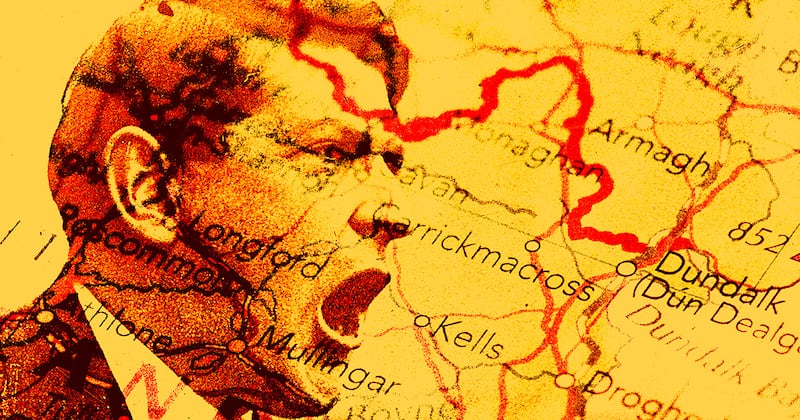It was a pet dog “wailing piteously” that led the locals of Dromore, Co Tyrone, to the bodies of the three men left lying on a patch of ground outside the village in the early hours of an April day 100 years ago. The dog had belonged to John Devine, who was missing after being taken from his home against his will some hours previously.
It was found crying, before running off in the direction of the railway station. Devine's sister followed the animal and, after travelling a few hundred yards, was confronted by the bloody corpse of her brother, accompanied by the bodies of two other local men: Charles Slevin and Daniel O'Doherty.
All three were Catholics and all three had disappeared, according to a contemporaneous report in a local newspaper, the Ulster Herald, after the arrival in Dromore of "armed men in motor conveyances". Frantic search parties had been despatched to the local police barracks and to the home of the local sergeant, but no light could be shed on the whereabouts of the missing men until Devine's dog put in his tragic performance.

It is hard to find a suggestion that any of the murdered men had been actively involved in the barracks attack
"Devine had apparently been shot through the head," the Herald reported starkly. Slevin and O'Doherty had wounds near the heart and in both arms. O'Doherty was "minus his cap, socks and boots".
Slevin was a grocer, O’Doherty a cycle mechanic and Devine a clothes dealer. Devine was approaching middle age, while the other two victims were in their 20s.
The night before the incident, Tuesday, a bomb had exploded in the middle of the tiny village, opposite the police barracks. A member of the B Specials, the infamous quasi-military reserve, was wounded.
“All day on Wednesday there was much activity by Crown forces in the village and district,” the Herald wrote. On Wednesday evening, locals reported hearing a volley of shots upon the arrival of the armed men into Dromore. The raids followed, and appear to have been targeted at particular houses, although it is hard to find a suggestion that any of the murdered men had been actively involved in the barracks attack. Slevin, according to the Herald, was taken from O’Doherty’s home, having been sleeping there because his own family house in the village had been damaged in the bomb attack of the previous night.
Slevin's mother, my great-great-grandmother, was also out of her home on the night of her son's murder, staying with a relative in nearby Omagh. She was a widow, her husband having died suddenly upon hearing of people being shot in the area four months previously.
“She did not learn of the tragic fate of her son until Thursday morning when another son came to Omagh by the first train,” the Herald wrote.
The newspaper acknowledged “a state of terror” in the area, reporting that many Catholic residents had left their homes after the event, in fear of further calamity.
“For some time past, the residents of the village have been subjected to much annoyance,” it reported simply.
The Irish Times thus described the scene in the village on the night of the murders: “The firing of shots was heard in the village shortly after midnight, and the windows of many of the business houses in the Main Street were smashed by the fragments, while many walls bear traces of bullet wounds”.
Military Archives testimonies from the period do speak of considerable tension in the area, including arrests, raids and, on the side of the Irish Volunteers, a high degree of organisation and subterfuge, supported by men sent from Dublin for this purpose. Similar situations would have been playing out all across Ireland in the spring of 1921.
There is no plaque to remember the three men in the village of Dromore, but their gravestones offer some small clues on the tragedy
One such testimony, from Volunteers member and Dromore native, Nicholas Smyth, described his group being "much annoyed" by the shootings, leading to a local decision to "shoot at sight any of the enemy we found". He went on to note a swift reminder from Dublin that they were soldiers and "must obey orders" and that this did not involve indiscriminate shootings. Smyth referred to the three victims as being "our men", and the Military Archives do indeed carry records of pension claims for O'Doherty (denied) and Devine (awarded), but not for Slevin.
In the end, three men were tried by court martial for the murders: Special Constables Archibald Griffin and John Gilmour and a soldier, Robert Bradley. They were acquitted, with a Manchester Guardian report on the case stating that witnesses did not identify the accused on the day after the murders ("They said they were afraid") but had done so later.
There is no plaque to remember the three men in the village of Dromore, but their gravestones offer some small clues on the tragedy. Slevin’s records his being “killed”, while Devine’s states that he was “brutally murdered for his faith”.
The incident occurred one month before the partition of Ireland and three months before the truce in the War of Independence. The Anglo-Irish Treaty was signed five months after that.
The Ulster Herald has produced a podcast on the Dromore Murders, working with local historian Pat McCusker. See ulsterherald.com







